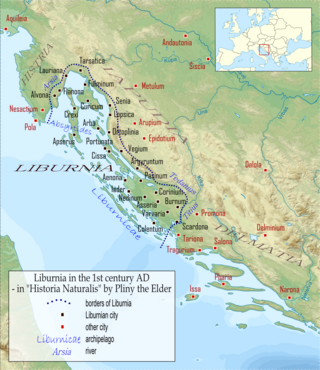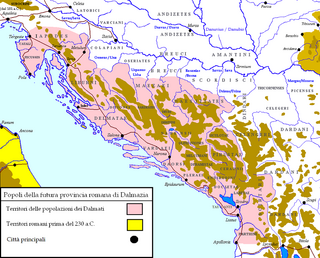Related Research Articles

The Iapydes were an ancient people who dwelt north of and inland from the Liburnians, off the Adriatic coast and eastwards of the Istrian peninsula. They occupied the interior of the country between the Colapis (Kupa) and Oeneus (Una) rivers, and the Velebit mountain range which separated them from the coastal Liburnians. Their territory covered the central inlands of modern Croatia and Una River Valley in today's Bosnia and Herzegovina. Archaeological documentation confirms their presence in these countries at least from 9th century BC, and they persisted in their area longer than a millennium. The ancient written documentation on inland Iapydes is scarcer than on the adjacent coastal peoples that had more frequent maritime contacts with ancient Greeks and Romans.
The Delmatae, alternatively Dalmatae, during the Roman period, were a group of Illyrian tribes in Dalmatia, contemporary southern Croatia and western Bosnia and Herzegovina. The region of Dalmatia takes its name from the tribe.
Damastion was an ancient city in the area of central Balkans, known for its silver coins dating back to the 4th century BC. It is attested only in Strabo who says that the city had silver-mines and locates it in Illyria. The ancient author reports that the city was under the authority of the Illyrian tribes of Dyestes and Enchelei-Sesarethii, and that Aegina colonized it. At 356–358 B.C. the mines came under the control of Macedon.
Mytilos or Mytilus was an Illyrian king who reigned in southern Illyria, around the hinterland of Dyrrhachion and Apollonia. He was the successor of Monunios, and probably his son. Mytilus is mentioned by Pompeius Trogus and Frontinus reporting the events of the military conflict between the Illyrians and the Epirotes under Alexander II, son of Pyrrhus. From around 270 BC Mytilus minted in Dyrrhachion his own bronze coins bearing the king's name and the symbol of the city.
Caravantius, an Illyrian, was half brother to Gentius, the last Illyrian king of the Ardiaean State. In 168 BC he fought with his brother against the Cavii.
Plator the Illyrian was brother to King Gentius, the last Illyrian king of the Ardiaean State.
Etuta was an Illyrian queen of the Ardiaean Kingdom, married to Gentius. Etuta was a Dardanian princess, the daughter of Monunius II of Dardania.

Delminium was an Illyrian city and the capital of Dalmatia which was located somewhere near today's Tomislavgrad, Bosnia and Herzegovina, under which name it also was the seat of a Latin bishopric.
Andetrium was an ancient city in Illyria, located in modern day Muć or Gornji Muć in the interior of Dalmatia, Croatia.

The Illyrian Kingdom is the name of a country that existed on the Western part of the Balkan Peninsula in ancient times and represented an alliance of Illyrian tribes that was under the rulership of a single leader, expressly referred to as "King of the Illyrians" in ancient historical records.
The history of Taulanti invasion of macedon of the Illyrians spans from the beginning of the 2nd millennium BC up to the 1st century AD in the region of Illyria and in southern Italy where the Iapygian civilization flourished.

Daorson was the capital of the Illyrian tribe of the Daorsi. The Daorsi lived in the valley of the Neretva River between 300 BC and 50 BC. They came very early into contact with Greek traders acquiring many facies of Greek civilization, and the town acquired a certain degree of Hellenization. After the peace treaty with Rome in 168/167 BC, the Daorsi minted their own coins.
The Varciani were a Celtic tribe in Roman Pannonia. They were neighbors of the Latobici.

Tilurium was an Illyrian fortified settlement of the Delmatae. Tilurium was the location a Roman cohort in the territory of the Delmatae. The site is now located on the hill of Gardun near Trilj.
Salvia was an Illyrian settlement in the region of Liburnia of the Illyrian tribe of Delmatae. The exact location is unknown, it is mentioned together with Stridon, possibly at Bosansko Grahovo.
The Roman–Dalmatian wars were a series of conflicts between the Dalmatae (Delmatae) and the Romans. After the fall of the Ardiaei in southern Illyria, the Dalmatae were to pose the greatest force against the Romans in their conquest of Illyria.

Mazaei or Maezaei were a sub-tribe of the Illyrians, autochthonous to the interior of today's Bosnia and Herzegovina, settled mainly in the Sana river basin, the middle course of Vrbas, and around the Vrbanja and Ugar rivers.
This is a list of Illyrian rulers from the Ardiean-Labeatan dynasty:
References
- ↑ Wilkes, J. J. The Illyrians, 1992, ISBN 0-631-19807-5, page 197, "... Illyricum 197 Promona, where the war-leader Verzo had stationed most of his army of 12,000 men. After some fighting the citadel was taken, ..."
- ↑ Zaninović, Marin (July 2008). "Beneficiarii consularis in the territory of the Delmatae". Contributions of Institute of Archaeology in Zagreb. Zagreb, Croatia: Institute of Archaeology. 24 (1): 181–182. ISSN 1330-0644.